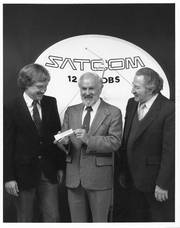Zum Auffrischen und Schmunzeln . . .
. . . sind diese Museums-Seiten hier gedacht, denn viele wissen nicht mehr oder noch nicht, wie es damals angefangen hat und wie das wirklich funktioniert mit den Tonband- und den Magnetbandgeräten aus alter Zeit. Viele Bilder können Sie durch Anklicken vergrößern, auch dieses.
Zwei Artikel aus 1976 - von Joe Roizen, einem der wenigen fachlich anerkannten Spezialisten.
Die Revolution durch den Video-Recorder 1956 - Teil 2
Im Rückblick gesehen . . .
In retrospect, all of the members of the small team that developed the Ampex VTR credit one individual for its eventual emergence. The accolade is not so much for his technical skills, which were considerable, as for his tenacity and purposeful single-mindedness in the face of every possible adversity that lack of time, money and technical precedent can impose. That man was Charles Pauson Ginsburg, a young obscure engineer who joined Ampex in late 1951, specifically to make pictures on tape and did so to the utter amazement of his peers in the rest of the industry. For the group working on the project, the most stirring moment occurred in February of 1956, and Ginsburg's own description of this event reflects the excitement experienced at that time.
"We gave a demonstration for what was originally supposed to be a very small management group, but turned out to be one attended by 30 people. For all of us on the project, this was the most dramatic demonstration we were to make. The guests arrived; they were seated; a few words were spoken to the fact that we would show them what we had produced, and the machine was then put back in the playback mode and played back a program which we had recorded an hour earlier."
The observers were quite intense as they watched the monitors. We then announced that we would record a sequence and immediately play it back. We recorded for about two minutes, rewound and stopped the tape and pushed the playback button.
Completely silent up to this point, the entire group rose to its feet and shook the building with hand clapping and shouting.
"The two engineers who had done more fighting between themselves than the rest of the crew combined shook hands and slapped each other on the back with tears Streaming down their faces.
Die ersten vorsichtigen Demonstrationen . . .
"We had quite a few visitors during the next couple of weeks, including Bill Lodge of CBS, Frank Marks of ABC and representatives of CBC and BBC. The visitors were all sworn to absolute secrecy and ushered in and out separately so they would not see each other. As a result of Bill Lodge's visit, arrangements were made to use a demonstration model, a Mark IV machine, which had not yet been built, for a surprise showing to the annual CBS affiliates meeting which was to occur the day before the formal opening of the NARTB convention."
With that goal now only two months away, the work load on the group became almost unbearable. Demonstrations in house had been with crude looking consoles and partially filled racks. Management gently suggested that a VTR in its potential price range should be packaged more attractively.
Anderson designed the Mark IV console with its compact rack mounting arrangement. Dolby having returned from the Army in 1955 developed the multivibrator modulator and other signal processing circuitry, including a lastminute head switching scheme tohide the transients in horizontal blanking. Even the administrative members of the group shed their business suits in favor of jeans and work shirts and along with the engineers spent their evenings and weekends making cable assemblies, modifying mounting brackets or wiring redesigned electronic units. The orphan of the system, audio which had been summarily neglected up to now was also improved to at least approach professional standards.
The super hero of this period was Fred Pfost, who experimented with heads up to the morning before his departure for Chicago. Worried about casting the System in concrete before he could optimize performance, he tried various tip structures, core structures, different numbers of core windings, gap spacing, guide setting, and current settings. All this while also building new heads continuously. Altogether an unbelievable amount of effort during this hectic period.
After the NARTB success, machines had to be built to meet the burgeoning orders, even while further work went on to achieve interchangeability, editing and color. The first 16 handbuilt units called VRX1000 were shipped to users who had to save the head with any tape made on it if they wanted repeated replays.
Endlich wird richtig gesendet - Finally.... On The Air
Television City in Los Angeles, CBS' production and delay center, was the first to air a videotape recording on November 30, 1956. It was the daily "Douglas Edwards News Show" that came from New York three hours earlier due to the time zones across America. Confidence at CBS in these new machines was not that high, and for a month, they ran a backup telecine in case of a breakdown. Headhunting was a major early problem that caused picture jitter for home viewers with receivers that had horizontal AFC circuits designed for fringe area reception. Viewer complaints instigated a crash program to alleviate this defect before CBS could make good their threat to take the machines off the air.
Ampex engineers literally slept in the VTR room to have access to the machines during non-broadcast hours, between one and five a.m. After one go-around, when they thought they had things fixed, they were rudely awakened by a self-explanatory telegram between CBS-Hollywood and New York headquarters which simply said, "The wages are restless tonight". A lot of midnight oil was literally burned to solve this problem. NBC followed suit in early 1957, and ABC started delayed tape broadcasts at the beginning of daylight saving time in April.
Television, being the highly communicative medium that it is, also served to publicize videotape to its own benefit. New developments came thick and fast, as not only the transverse VTRs were updated or unproved but new formats invaded a great variety of applications.
Regardless of the seeming simplicity and wide usage of video recording today, the fact remains that most of the latter day breakthroughs (with a few exceptions) qualify for Ray Dolby's description a "just competent engineering".
To the five men who each brought their spark of intuitive genius to bear on a seemingly insurmountable barrier, then applied the copious toil and sweat needed to create the working model, goes the credit for opening up this field to the benefit of those who folllowed. The personal satisfaction that must be theirs is one that all memers of this society can appreciate.
Where Are They Now?
Even successful teams eventually disperse and, of course, the VTR group followed that pattern. Their present commonality is that they all still work in some engineering capacity closely related to video recording even though some of them are with different organizations.
Ginsburg and Anderson have remained with Ampex. Ginsburg is vice president of advanced research in video, a post which he has held for some time. He has received almost every honor the television industry and the professional societies can bestow, including the Sarnoff Medal, the Valdemar Poulsen Award, the Zworykin Medal, and many more.
Charles Anderson has had a variety of engineering management positions with Ampex and is now in charge of long range video product planning, a task he is eminently suited for in view of his background and present activities. Anderson's major contribution to the television industry after being dubbed the "Father of FM Recording" have been mainly in his standardization work with the SMPTE and the IEC. He is past chairman of the SMPTE VTR standards committee, where he helped formalize the standards and recommended practices on quadru-plex VTRs.
Alex Maxey took one of his own best ideas, segmented helical scanning, and left Ampex in the midsixties to build a separate organization around it. Westel, the new company, did not achieve any penetration of the broadcast field, but the unique characteristics of this segmented helical VTR made it ideal for high altitude reconnaissance or military applications. Maxey remained with his new company as vice president of engineering through two acquisitions, which changed the name to Echo Science and the ownership from Dictaphone to Arvin.
Fred Pfost also left Ampex in the midfifties and went into private consulting work. His unique and highly specialized knowledge about video heads became a critical element in video projects other companies were pursuing in Tape Recorder Alley (a euphemism for the area around Redwood City). He contributed significantly to the first slow/stop motion discs made by MVR and later by DMI. He assisted another group in setting up a video head refurbishing business which is now Videomax Corp.
Ray Dolby has perhaps fared the best in terms of fame and fortune, none of which is directly attributable to Ampex. He completed his university studies at Stanford while working parttime. His brilliant academic record garnered him a Marshall Scholarship which brought him to England, where he obtained his doctorate in Physics at Cambridge. He developed a noise reduction scheme in electron microscopy and later did the same in the audio recording field. His patented and proprietary audio noise reduction system was quickly recognized as a boon to the tape recording industry and Dolby built a substantial enterprise which both manufactures and licenses his process.
Quellenhinweise (ebenfalls aus 1976)
Acknowledgements:
The compilation of this VTR history required more than the inputs of the original inventors since both the prior art and user experience helped to make a coherent story.
Prior art came from many sources, including:
- Dr. Peter Axon, Stoneplatt Industries;
- John Baldwin, IB A;
- Ted Barger, Echo Science;
- Blair Benson, Goldmark Communications;
- Peter Blaxtan, Rank Cintel;
- Yves Faroudja, Yves Faroudja Inc.;
- Jerry Grever, RCA;
- Hans Groll and von Felgel Farnholz, Fernseh GmbH; and
- James Redmond, BBC.
References were made to: RCA Review, circa '54 and '56 Library; BBC Engineering 52, 72 E. Pauley; Handbuch des Bildtelegraphie, Dr. F. Schroeter 1932; Marzocci Patent, 1948; Ginsburg et al. Patent, 1960; Schueller Patent, 1953; Wireless World 75 Years of Magnetic Recording; and SMPTE Journals, 58-60.
reservierter Text
The inventors and the Vice President of Ampex Surround a VRX-1000 which was about to be delivered. From left to right they are Phil Gundy, Shelby Henderson, Alex Maxey, Fred Pfost, Ray Dolby, Charles Ginsburg, and Charles Anderson.
Ray Dolby is shown here operating the VRX-1000 in the CBS suite in the Conrad Hilton in April, 1956. Dolby went on to form his own Company which manufacturers noise reduction Systems.



